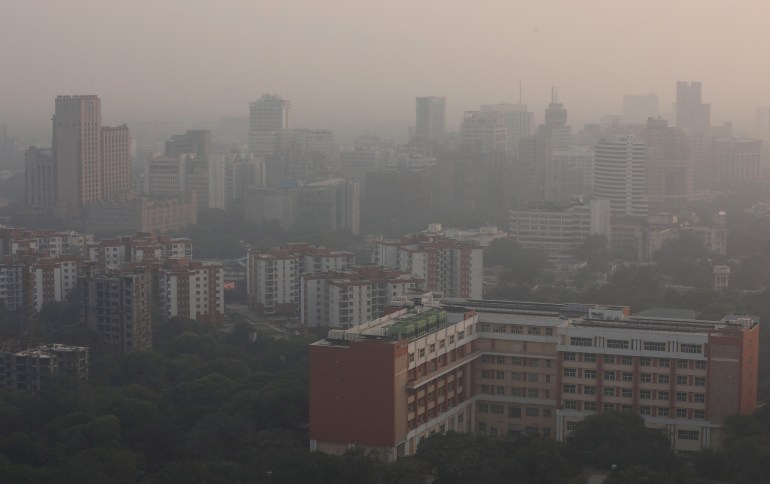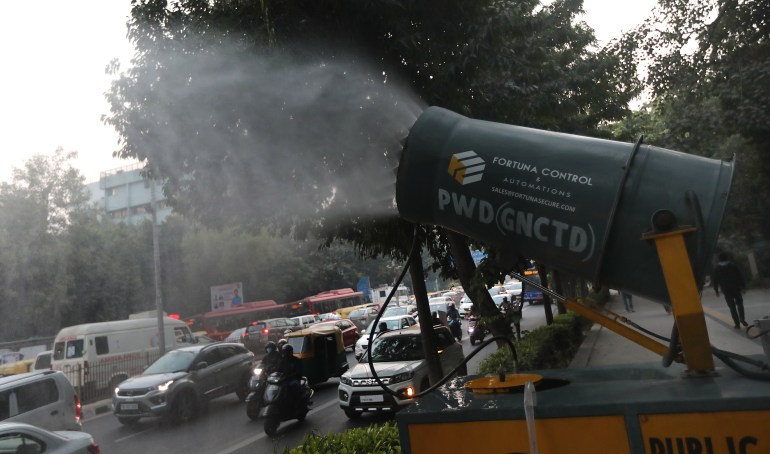Schools in Indian capital shut indefinitely as smog worsens
Residents urged to work from home and trucks carrying non-essential goods banned as New Delhi’s air pollution hits dangerous levels.

New Delhi has shut down schools until further notice, urged people to work from home and banned non-essential trucks from entering the Indian capital due to dangerous levels of air pollution.
One of the world’s most polluted cities – home to some 20 million people – New Delhi is cloaked every winter in a thick blanket of smog.
Keep reading
list of 4 itemsWhy air quality has deteriorated sharply in India’s capital
India celebrates Diwali amid air pollution, COVID fears
After rare clean spell, air quality set to drop in Indian capital
On Saturday, the Delhi state government had ordered schools to close for a week and banned construction work for four days.
But in an order passed late on Tuesday, the Commission for Air Quality Management for Delhi said all educational institutions should remain shut until further notice.

Five coal-fired power plants around New Delhi have also been temporarily shut down, according to an order from the panel on air pollution, which comes under the federal Ministry of Environment, Forest and Climate Change.
Trucks except those carrying essential goods are barred from entering the capital until November 21 and most construction activities in Delhi and its neighbouring cities were halted, the order said.
“Anti-smog guns” and water sprinklers were ordered to operate at hotspots at least three times a day.
The commission also said at least 50 percent of staff employed in government should work from home until November 21 and encouraged those in private firms to follow suit.
The order comes days after the Delhi government pushed back against a call by India’s Supreme Court to declare a “pollution lockdown” – a first – which would restrict the city’s population to their homes.
The top court also rapped the federal and local governments over their failure to mitigate pollution.
Experts urge round-the-year action
Anumita Roy Chowdhury of New Delhi-based Centre for Science and Environment told Al Jazeera the emergency measures announced by the Delhi government “cannot solve the problem of air pollution” in the city.
“For that, we require round-the-year action on key sources of pollution so that more permanent solutions can be worked out,” she said.
Environmental activist Bhavreen Kandhari said she was “extremely angry and disappointed” that the children “are once again home” after a long spell of coronavirus-enforced lockdown.
“The government has to take actual strategic actions and not photo-optic solutions like smog towers and putting posters everywhere,” she told Al Jazeera.

New Delhi, among the world’s most polluted capital cities, battles chronic winter smog every year as a drop in temperatures trap deadly pollutants from coal-fired power plants outside the city, fumes from vehicles, construction activity, and open burning of rubbish.
One of the key contributors to the air pollution in winter is the smoke from farmers burning their crop residue in neighbouring states.
The government, however, told the Supreme Court that industry was the biggest contributor followed by vehicular pollution and dust.
This week, PM 2.5 levels – harmful particulate matter small enough to enter a person’s bloodstream when inhaled into the lungs, causing chronic lung and heart disease – have been above 400 in several parts of the city.
Last week, the levels touched 500, which is more than 30 times the maximum limit recommended by the World Health Organization.
A Lancet report in 2020 said almost 17,500 people died in Delhi in 2019 because of air pollution. Another report by Swiss organisation IQAir last year found that 22 of the world’s 30 most polluted cities were in India.